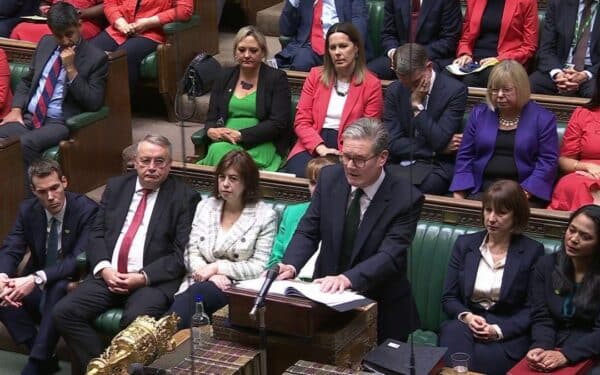In the 1990s, it was decided that 50 per cent of young people should attend university. The target was set and, in 2017-18, it was met. High-achieving economies have a large proportion of their populations educated at university, so there was much to be said for increasing the number of Britons who had the chance to experience higher education.
But how to pay for it? To offset the growth in public spending caused by rising university attendance rates, student loans were introduced in place of the old maintenance grants that subsidised undergraduates in the days when they were far fewer in number. Student loans were brought in under Margaret Thatcher’s government, but did not become the universal funding arrangement for higher education until the Blair government, in 1998. The 2004 Education Act increased tuition fees from £1,000 to £3,000 and by 2005-06 the Student Loan Company was lending £2.79bn to 1,080,000 students.
The present arrangements were set for students attending university from 2012 onwards. Tuition fees were capped at £9,250 a year for home students. In 2022 three changes were announced to student loans. The repayment threshold was frozen at its 2021-2022 level of £27,295 until 2024-2025, instead of rising with average earnings; from 2025-2026 the threshold will rise in alignment with the Retail Prices Index (RPI), increasing more slowly than previously; and the interest rate thresholds will also rise in line with RPI.
Those changes imposed higher loan repayments than before on many graduates. In average terms, graduates from the 2022 cohort will repay £11,600 more in real terms over their lifetimes. Worst hit will be middle-earning graduates, expected to pay £20,000 more on average.
For university starters in 2023 and later, the repayment period after which loans are written off has been extended from 30 to 40 years, with some potentially paying into their 60s. But the injustice written into the new terms is that higher earners able to repay their loan in full will accrue less interest and be able to complete payment earlier; yet low earners will pay considerably more, repaying a higher amount each year because of the lower repayment threshold and will be obliged to pay for a longer time, due to the extended loan term.
The inequities of the system are iniquitous. The 2022 changes mean that middle-earning graduates who started university that year will pay around £20,000 more, with the government write-off reduced to about 2 per cent of their collective loans. The 2023 terms were marginally more favourable to graduates, leaving a middle-earner around £43,000 in repayments, as distinct from a 2022 starter paying £47,000. The vagaries of the system, aggravated by capricious government policy changes, are extravagant.
Even more Byzantine is the operation of interest rates. At present, graduates are being charged interest at between 6 per cent and 8 per cent on loans of around £45,000. This means that the interest charge is about £3,000 a year, alongside a loan repayment of slightly over £1,000. This brings in revenue of £4bn to the Exchequer. But the total interest charge on £200bn outstanding in student loans is between £12bn and £14bn. So, the full interest is not actually being repaid by students. It is all smoke and mirrors. The bottom line is that more than 30 per cent of student loans will never be repaid, since graduates reach cut-off age for repayment before the balance is taken out of their income.
But, if that sounds as if graduates are getting away with part of their education as a free ride, it is a false impression. The burden of student loan debt is a serious cause of stress to graduates and, worst of all, a significant barrier to home ownership. Graduates on modest salaries face a huge challenge getting onto the property ladder: in the struggle to obtain an affordable mortgage, the £4,000-plus annual liability of loan repayments and associated interest can be the final obstruction to buying a home, with further repercussions such as delay in starting a family.
It also makes budgeting a nightmare. In February, one graduate shared on X her latest loan repayment details so far for the year, showing HMRC acknowledging a payment of £1,059, while charging interest of £3,092. She was being charged interest three times the amount of her repayment and her total loan is now almost £10,000 larger than when she left university. That is the reality that lies behind the plausible-sounding government announcements and policy glosses on a student loans system that is not fit for purpose. Many graduates have lost track of their debt and are baffled by its intricacies.
If new borrowers are to be given relief on interest, why not extend that amelioration to all post-2012 graduates? Aggrieved graduates complain that, when inflation and interest rates were rising the rate was updated every month, but since they came down the system has been changed to an annual review, leaving people still paying at inflated October 2023 rates today. That is a typical inequity of the chaotic system.
Consumer champion Martin Lewis commented last year on student loans repayment: “We should stop calling it a student loan. This is a tax. It is a hypothecated, limited form of taxation. We should rename this. This is a graduate contribution system.” He also said of the 2023 changes to the system: “For most people, it will be like a 9% additional tax burden above the £25,000 threshold. Many university leavers will end up repaying more than double what they do under the current conditions.”
Clearly, this is a system crying out for root-and-branch reform. Above all, the devil is in the interest payments. Enter Labour, in its benevolent, voter-wooing mode, some time before the recent election. In June 2023, the then shadow education secretary Bridget Phillipson wrote an article for The Times, full of tantalising possibilities. She said the “government could reduce the monthly repayments for every single new graduate without adding a penny to government borrowing or general taxation”.
Bridget Phillipson had previously said she was considering proposals to “reduce the monthly payments” and put money back into the pockets of “every single graduate” under a Labour government. However, when the Labour manifesto was published this year it contained not one word about reforming student loans. In 2020, Keir Starmer made a commitment to scrap tuition fees a focal point of his leadership campaign, following a similar commitment in Labour’s 2017 and 2019 manifestos, but he resiled from that pledge in May 2023, promising instead to offer a “fairer solution”. What that might be, nobody knows, possibly including the Prime Minister. Meanwhile, appeasement handouts to striking doctors and train drivers are a higher priority for Labour.
There are signs that slightly fewer youngsters are applying for university and the student loans system may play a part in that decision. The root problem with student finance is the enormous percentage of 18-year-olds entering higher education. In the context of highly vocational subjects such as medicine, dentistry, science, and so on, a university degree is indispensable. It is also a cultural benefit to the nation that people should develop their minds by studying the humanities, in the sense of established disciplines such as the Classics and Literature.
But would many youngsters better prepare themselves for life and debt-free careers by entering apprenticeships? Is it, in some cases, merely intellectual snobbery or parental pressure that prompts some university applications? In more radical terms, should we somewhat reduce not only the number of undergraduates, but also the number of universities, in favour of a more balanced system of education and training? That could eventually enable a return to the old system of better maintenance grants. These and other radical ideas should at least be up for debate.
Meanwhile, the bottom line is that graduates on an average salary are effectively paying 40 per cent income tax when their student loan is factored in. After delaying earning for three or four years, they enter the workplace burdened with a debt that will oppress them for around four decades. In a cut-throat housing market, that albatross around their necks may be the crucial impediment to acquiring a home.
The system is unjust, incoherent and out of control. And the interest rates charged are a national scandal.
Viewed objectively, with all the governmental formalism and jargon stripped away, it looks like a scam. It is acting as a drag-chain on the key element of the population we rely on to grow our economy and infuse our society with creative energy. We cannot go on like this, nor can we permit the government to bury its head in the sand, in the vain hope that the issue will go away. Reform should be an urgent priority.
Write to us with your comments to be considered for publication at letters@reaction.life




